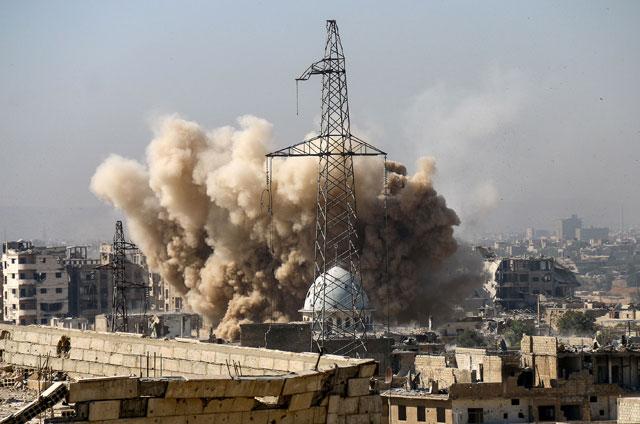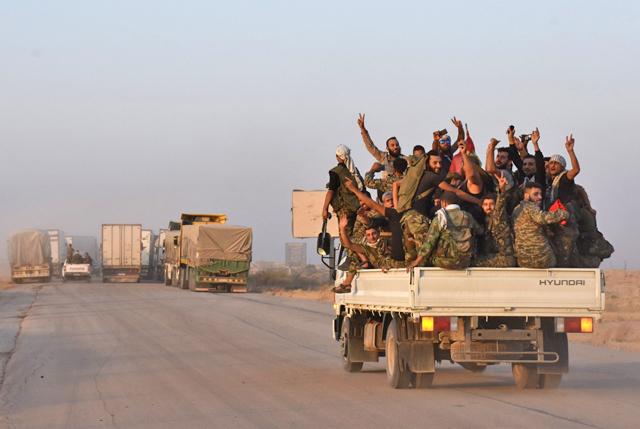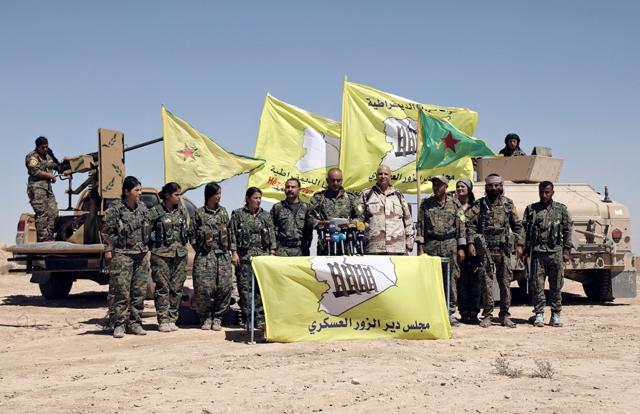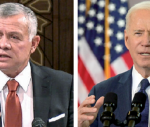You are here
As fighting ebbs in west Syria, army looks east
By AFP - May 11,2017 - Last updated at May 11,2017

A still image taken from a video posted to a social media website and said to be taken on Monday, shows smoke rising after what purported to be air stikes hit an area said to be Latamneh, in Hama province, Syria (Social media website via Reuters TV)
BEIRUT — With hostilities subsiding on Syria's western battlefronts, President Bashar Assad's army is seeking to head off US-backed forces fighting extremists further east, analysts and military sources in Damascus say.
Violence has diminished in parts of central and western Syria after a deal signed last week in the Kazakh capital Astana to introduce four "de-escalation zones" aimed at paving the way for a lasting ceasefire.
The agreement, brokered by rebel backer Turkey and government allies Iran and Russia, leaves out valuable border lands in eastern Syria, including the oil-rich province of Deir Ezzor.
Observers say Syrian government troops plan to seize swathes of that territory from extremists — but also from rival groups backed by the United States.
"This truce will allow a part of the Syrian army to redeploy east towards positions held by the Daesh terror group, chiefly near the Iraqi border and towards Deir Ezzor city," said Waddah Abed Rabbo, editor-in-chief of the Al Watan daily.
"It's a question of refusing to allow the US and the forces it supports to occupy the country's east," said Abed Rabbo, whose paper is close to the government.
Under the Astana deal, "de-escalation zones" will be created in four areas: the northwestern province of Idlib, parts of the central province of Homs, the south, and the opposition enclave of Eastern Ghouta near Damascus.
But the eastern Syrian desert, which is not included, is divided between Daesh, Kurdish militia, the US-backed Syrian Democratic Forces (SDF) and an Arab rebel group known as the Maghawir Al Thawra (Commandos of the Revolution).
Three-pronged approach
The SDF, an alliance of Kurdish and Arab fighters, is focused on driving Daesh out of the extremists' de facto Syrian capital, Raqqa, but analysts expect they will turn towards Syria's coveted eastern border next.
“Once this happens, it’s better for the Syrian army to advance east too,” said Fabrice Balanche, a Syria expert at the Washington Institute.
“If Assad wants to keep Syria united, he also needs the so-called ‘un-useful’ part of the country too,” he added.
Indeed, Assad’s forces appear to be on alert for a Washington-backed drive for the frontier territory.
“The US is pushing the groups it supports to take full control of the Syrian-Iraqi border,” a Syrian government official said.
A senior military source in Damascus told AFP that, in response, Syria’s army would push east in a three-pronged approach.
First, troops were working through territory in Hama province, which lies adjacent to the province of Deir Ezzor.
Second, government fighters in Homs province would sweep east from the ancient city of Palmyra, which they recaptured from Daesh in March in a Russian-backed offensive.
They would aim for Sukhnah, a key town on the highway between Palmyra and Deir Ezzor.
The third axis would focus on Al Tanaf, a strategic border crossing between Syria and Iraq that lies on a highway linking the capitals of the two countries.
The first two assaults would aim to break Daesh’s two-year siege on Deir Ezzor city, where a Syrian military expert says 7,000 government troops are trapped.
“At least 15,000 fighters will be needed to lift Daesh’s siege,” said the expert, who spoke on condition of anonymity.
The third drive for Al Tanaf, though, would put Syrian troops in confrontation with the US-backed Maghawir Al Thawra.
According to the military expert, Syria’s army “is trying to reach Al Tanaf in coordination with the Russians to prevent the Americans from spreading further east.” Reconquering Syria’s east will be a tall task for government troops, whose numbers have been strained by deaths and defections during the deadly six-year war.
More than 320,000 people have been killed since the conflict erupted with anti-Assad protests in 2011.
Related Articles
BEIRUT — Extremists launched an offensive against government-held parts of northwestern Syria near Hama on Tuesday in their biggest attack t
BEIRUT — Syria's army sent massive reinforcements to territory under its control in Deir Ezzor on Monday ahead of a final push for the Daesh
BEIRUT/AL SHADADI, Syria — US-backed militias and the Syrian army advanced in separate offensives against the Daesh terror group in eastern
















